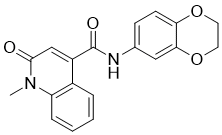CeMMEC13 is a selective inhibitor of TAF1. CeMMEC13 acts on the bromodomain of TAF1 but does not bind to bromodomains of BRD4, BRD9, or CREBBP. CeMMEC13 and (+)-JQ1 prevent THP-1 and H23 lung adenocarcinoma cells from proliferating.
Physicochemical Properties
| Molecular Formula | C19H16N2O4 |
| Molecular Weight | 336.35 |
| Exact Mass | 336.11 |
| Elemental Analysis | C, 67.85; H, 4.80; N, 8.33; O, 19.03 |
| CAS # | 1790895-25-8 |
| Related CAS # | 1790895-25-8 |
| PubChem CID | 110694558 |
| Appearance | Solid powder |
| Density | 1.4±0.1 g/cm3 |
| Boiling Point | 541.4±50.0 °C at 760 mmHg |
| Flash Point | 281.2±30.1 °C |
| Vapour Pressure | 0.0±1.4 mmHg at 25°C |
| Index of Refraction | 1.673 |
| LogP | 2.69 |
| Hydrogen Bond Donor Count | 1 |
| Hydrogen Bond Acceptor Count | 4 |
| Rotatable Bond Count | 2 |
| Heavy Atom Count | 25 |
| Complexity | 576 |
| Defined Atom Stereocenter Count | 0 |
| SMILES | O1CCOC2C=CC(=CC1=2)NC(C1=CC(N(C)C2C=CC=CC=21)=O)=O |
| InChi Key | NXKBPGZQDHACPZ-UHFFFAOYSA-N |
| InChi Code | InChI=1S/C19H16N2O4/c1-21-15-5-3-2-4-13(15)14(11-18(21)22)19(23)20-12-6-7-16-17(10-12)25-9-8-24-16/h2-7,10-11H,8-9H2,1H3,(H,20,23) |
| Chemical Name | N-(2,3-dihydro-1,4-benzodioxin-6-yl)-1-methyl-2-oxoquinoline-4-carboxamide |
| Synonyms | CeMMEC-13; CeMMEC 13; CeMMEC13 |
| HS Tariff Code | 2934.99.9001 |
| Storage |
Powder-20°C 3 years 4°C 2 years In solvent -80°C 6 months -20°C 1 month |
| Shipping Condition | Room temperature (This product is stable at ambient temperature for a few days during ordinary shipping and time spent in Customs) |
Biological Activity
| Targets | TAF1 ( IC50 = 2.1 μM ) |
| ln Vitro | CeMMEC13 has an IC50 of 2.1 μM, making it a nevel inhibitor of the TAF1 (2) bromodomain. CeMMEC13 exhibits negligible or no effects on BRD4, CREBBP, and REDNESS. CeMMEC13 (0–20 μM) combined with (S)–JQ1 effectively lowers H23 and THP1 cell viability while also increasing RFP expression in REDS3 cells, outperforming single treatment[1]. |
| References |
[1]. Mapping the chemical chromatin reactivation landscape identifies BRD4-TAF1 cross-talk. Nat Chem Biol. 2016 Jul;12(7):504-10. |
Solubility Data
| Solubility (In Vitro) |
DMSO : 16.7~67 mg/mL(49.6~199.2 mM) Ethanol : 6 mg/mL (~17.8 mM) |
| Solubility (In Vivo) |
Solubility in Formulation 1: ≥ 2.5 mg/mL (7.43 mM) (saturation unknown) in 10% DMSO + 40% PEG300 + 5% Tween80 + 45% Saline (add these co-solvents sequentially from left to right, and one by one), clear solution. For example, if 1 mL of working solution is to be prepared, you can add 100 μL of 25.0 mg/mL clear DMSO stock solution to 400 μL PEG300 and mix evenly; then add 50 μL Tween-80 to the above solution and mix evenly; then add 450 μL normal saline to adjust the volume to 1 mL. Preparation of saline: Dissolve 0.9 g of sodium chloride in 100 mL ddH₂ O to obtain a clear solution. Solubility in Formulation 2: ≥ 2.5 mg/mL (7.43 mM) (saturation unknown) in 10% DMSO + 90% (20% SBE-β-CD in Saline) (add these co-solvents sequentially from left to right, and one by one), clear solution. For example, if 1 mL of working solution is to be prepared, you can add 100 μL of 25.0 mg/mL clear DMSO stock solution to 900 μL of 20% SBE-β-CD physiological saline solution and mix evenly. Preparation of 20% SBE-β-CD in Saline (4°C,1 week): Dissolve 2 g SBE-β-CD in 10 mL saline to obtain a clear solution. Solubility in Formulation 3: ≥ 2.5 mg/mL (7.43 mM) (saturation unknown) in 10% DMSO + 90% Corn Oil (add these co-solvents sequentially from left to right, and one by one), clear solution. For example, if 1 mL of working solution is to be prepared, you can add 100 μL of 25.0 mg/mL clear DMSO stock solution to 900 μL of corn oil and mix evenly. (Please use freshly prepared in vivo formulations for optimal results.) |
| Preparing Stock Solutions | 1 mg | 5 mg | 10 mg | |
| 1 mM | 2.9731 mL | 14.8655 mL | 29.7309 mL | |
| 5 mM | 0.5946 mL | 2.9731 mL | 5.9462 mL | |
| 10 mM | 0.2973 mL | 1.4865 mL | 2.9731 mL |
